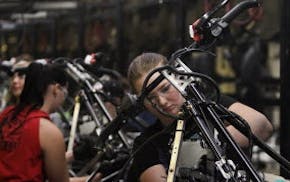By Don Lee • Los Angeles Times
TOKYO – Japanese Prime Minister Shinzo Abe has an unprecedented plan to boost economic growth and shore up his country's shrinking labor force: help more women return to work.
About two-thirds of Japanese women leave the workforce after the birth of their first child. Most do not return for years, if ever. It's a major reason the employment rate of Japanese women is one of the lowest in developed economies, particularly among those married and well-educated.
Abe's government wants to change that situation for women such as Saori Tachibana.
Drifting in a dead-end clerical job despite her college degree, Tachibana figured that, at 30, she had better buck up if she wanted financial independence. So, for 10 months, she juggled her full-time work with Saturday classes and studied day and night to become a certified labor consultant.
Her efforts paid off with a good job at a legal and accounting firm in Tokyo. But when she got married and became pregnant, her company pressured her to leave.
"They didn't say directly for me to quit," she said on a recent evening, sitting in a 700-square-foot apartment in Tokyo's Koto district that she shares with her husband, Shingo, and their 2-year-old son, Harushi.
"I told them that my husband was even planning to take a long child-care leave so I could keep working," she said, "but the company wasn't willing to let me stay."
That kind of outcome doesn't sit well with Abe's government, which won a convincing parliamentary election last month. It has pledged to raise Japan's labor participation of women to the world's highest level and is urging companies to promote women.
"It is essential for the 'power of women' — Japan's greatest potential, which had not been leveraged fully to date — to be fully utilized," according to Abe's growth plan.
The government's plan promotes maternity leave and would expand public child-care centers. Firms would get financial incentives to hire more women. In addition, some groups are trying to break ages-old cultural norms about women single-handedly raising children by portraying men who play the role of child caregiver as caped heroes.
Behind that drive is the country's acute need to expand its labor pool.
Because of its rapidly aging population, very low birthrate and long-standing opposition to any meaningful increase in immigration, Japan's working-age population is projected to fall to about 55 million in 2050 from a peak of 87 million in 1995, economist Chad Steinberg of the International Monetary Fund said.
As many as 8 million
Japan could add as many as 8 million workers if it brought the employment rate of women up to that of men, analysts calculated. That would provide a huge boost to household incomes, consumer spending and the broader Japanese economy, which has been stagnant and mired in deflation for most of the past 20 years.
Abe is the first prime minister to formally include the utilization of women's labor in the country's growth strategy, said Shizuka Takamura, a Tokyo University researcher and former analyst at Japan's Gender Equality Bureau.
The government's plan comes amid other signs of change, Takamura said, including decisions by Tokyo and some local governments to increase the availability of day-care centers.
Even so, she and most other experts think change will come very slowly.
The pressure to quit that Tachibana experienced is illegal in Japan, just as it is in many other countries. Japanese law guarantees pregnant women six weeks of leave before birth and eight weeks after, and some companies allow up to three years of maternity leave.
But reality doesn't work that way at many companies, especially smaller ones.
Tachibana said she could have complained publicly or taken the case to arbitration or court, but few Japanese women do that because of cultural resistance and the stigma attached to such disputes.
Shares of Walmart-backed Ibotta soar 23% on public debut
Tesla shares tumble below $150 per share, giving up all gains made over the past year
Average long-term US mortgage rate climbs above 7% to highest level since late November
Sluggish start for spring homebuying season as home sales fall in March with mortgage rates rising

